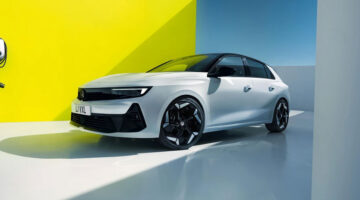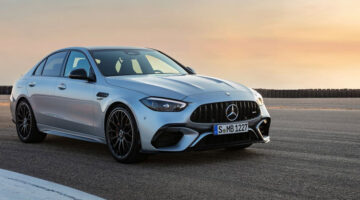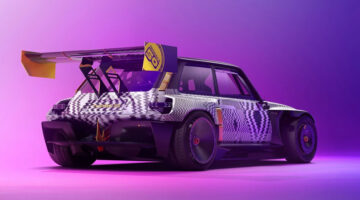An insight in to the future of Volkswagen and a drive in the CrossBlue Concept in Germany
[Not a valid template]The Volkswagen CrossBlue is a concept that made its debut at the Detroit Motor Show. While no official confirmation has been released that this midsize CUV will reach production, that doesn’t mean we can’t drive it on a closed airfield in Germany. About now, Jeremy Clarkson will mentally be doing the voice over in your head saying “A journalist. A car. A closed runway. Let the fun begin…” but not so fast. No, I mean literally not so fast…
Our speed in the CrossBlue will be limited to approximately 30kph and, if the weather continues to put a dampener on things, we might only be able to drive it in an aircraft hanger. The reason for this is the CrossBlue is a concept vehicle. Unlike most concept vehicles, it is fully drivable and even has an engine or three. It is still a hand-built concept vehicle though and, therefore, probably one of the most expensive cars I will ever get to drive. Volkswagen are therefore understandably very protective.
While driving a car in a shed might not sound like the most exciting thing in the world to do, it isn’t really why we are here. The CrossBlue Concept is a showcase of new technology, an indication of Volkswagen’s design direction and an insight in to the marque’s plan to become the world’s largest car manufacturer by 2018. So, what is the Volkswagen CrossBlue Concept?
The CrossBlue is a three-row, midsize crossover utility vehicle and is specifically designed for the North American market. This is a highly competitive segment and Volkswagen clearly want a slice of the pie. With a target of selling 800,000 vehicles in the United States alone by 2018 the chances that the CrossBlue will see production is therefore quite high.
Although designed in Germany under the leadership of Walter de Silva (Head of Design, Volkswagen Group) and Klaus Bischoff (Head of Design, Volkswagen Brand) close coordination with Volkswagen America played a large part in visualizing the final concept which is described as merging “the clean lines of German Volkswagen design DNA with the masculine character of an American SUV”.
The flared wheel arches and massive 21-inch wheels (which are unlikely to be present on the production model) emphasize the CrossBlue’s visual muscularity. They also create a slight optical illusion in judging the size of this concept. Make no mistake, the CrossBlue is a large vehicle at 4,987mm long, 2,015mm wide and 1,733mm tall. To put that in to context, it is longer and wider than a Touareg although not quite so tall.
The interior is light, spacious and uses aluminum accents and banana tree wood to create a very modern and pleasant ambience in the cabin, a contrast to the ‘masculine and muscular’ exterior. A prominent, centrally mounted 10.2-inch touchscreen display, with Pink Floyd’s ‘Wish You Were Here’ on screen (nice touch), houses all the necessary infotainment data and gives the cockpit an uncluttered feel.
The purpose of the CrossBlue, however, is its troop carrying ability. While the concept has six individual seats, a seven seat option is also possible. The second row has plenty of leg and head room and even adult passengers can recline comfortably in the third row seating. Access to the third row is also quite simple as the second row slides easily forward. It is the technology that is hidden underneath all this seating that makes this concept stand out.
The CrossBlue Concept is a plug-in diesel hybrid. The 188bhp, four-cylinder turbocharged diesel engine drives the front wheels when it is the sole source of power but is also combined with two electric motors. An 85-kW motor powering the rear wheels can be used for ‘zero emission driving’ with a range of about 22km and maximum speed of 120kph. There is also a further 40kW e-motor nestled in beside the diesel lump at the front and acts as a generator charging the rear e-motor. Total output is estimated at 302bhp with an impressive 517 lb/ft of torque powering all four wheels via a six-speed, dual-clutch auto box and very clever “propshaft by wire” technology since the energy for driving the rear wheels is directed electrically and not mechanically.
This hybrid technology will no doubt be a key selling point if the CrossBlue does see production with estimated test cycle fuel consumption figures of around 2.1-litres per 100km. However, as the CrossBlue utilizes Volkswagen’s MQB architecture – the marque’s new platform – the production model could also easily be offered with a variety of powertrains including a conventional V6 petrol engine.
Unfortunately, the weather isn’t so kind for our spin in the CrossBlue and it does become a drive around a shed. On starting the car it acts like a traditional hybrid with the diesel engine coming to life shortly after driving off – should I require maximum power which, under the circumstances, is unlikely. In E-mode the diesel engine completely shuts down and power is directed to the rear wheels solely by the rear-mounted electric engine.
Needless to say, in all modes I fail to reach the lofty speed limit of 30kph but I do test out the CrossBlue’s tighter than expected turning circle and also perform several ‘figure of eight’ manouvres within the hangar.
While a firm decision to put the CrossBlue in to production has not yet been made, it would appear likely that it will get the green light. Having a three-row, midsize crossover utility vehicle in the Volkswagen portfolio would certainly seem the logical move in the marque’s plan to become the world’s largest car manufacturer by 2018.



